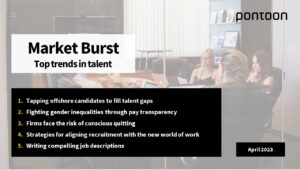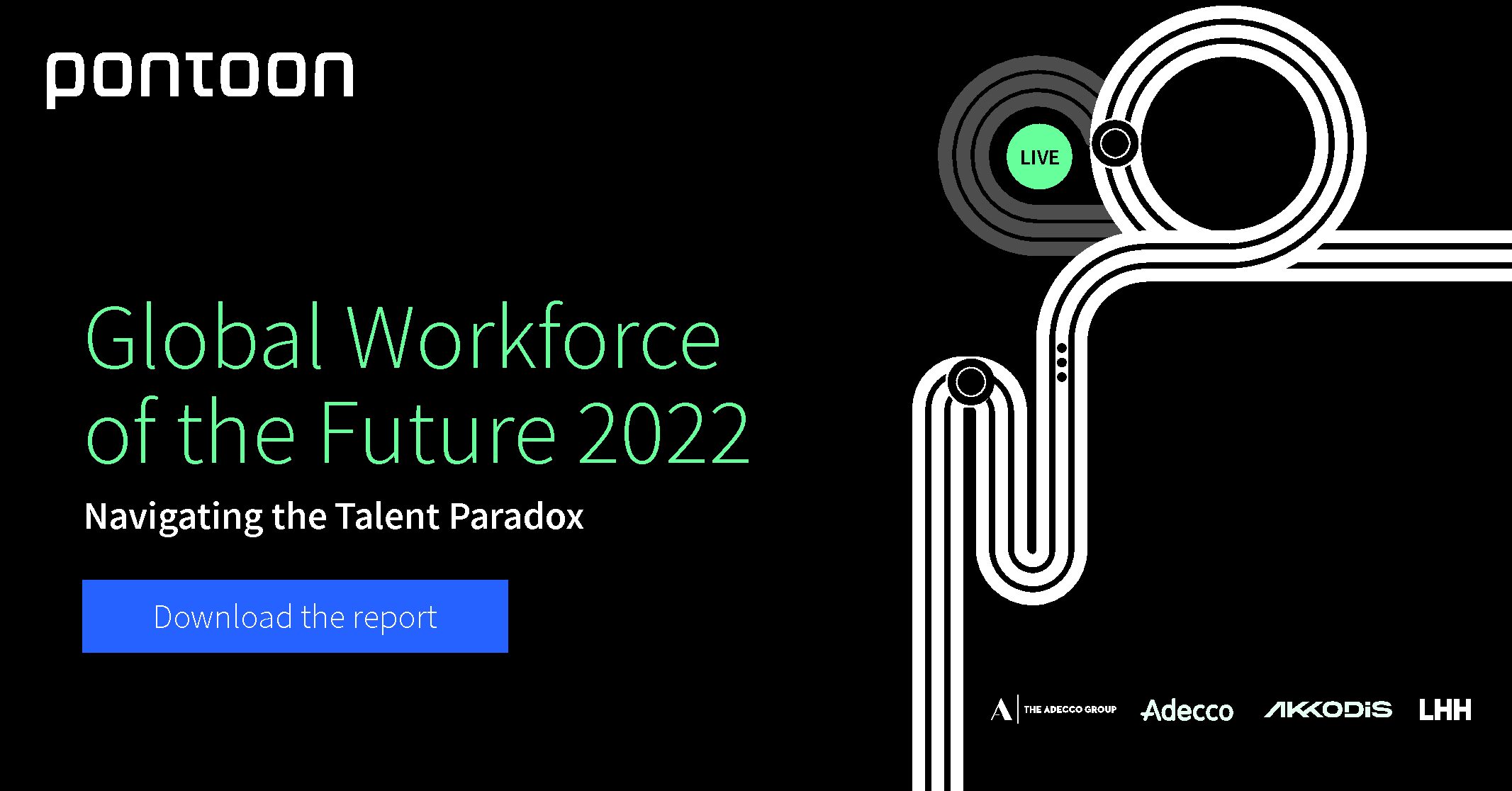Market Burst: April 2023
Read about top trends in the world of work.
In this month’s instalment of our Market Burst, we dive into the trends that continue to drive talent management in the evolving workspace. These include hiring offshore talent, pay transparency, the risk of conscious quitting, and more.
Tapping offshore candidates to fill talent gaps
World Economic Forum recently released a 2023 unemployment forecast that shows some striking disproportions. While a few countries project the lowest unemployment figures in a century, others expect rates of more than 5% or 10%.
This poses a challenge for people in economies that struggle to navigate a strong labour market against recession. At the same time, however, we can expect the talent pools of available offshore candidates to expand. Since we now live in the open talent economy, firms that struggle to fill their roles can tap candidates from abroad to close gaps in their workforce.
For example, Brazil – with a projected unemployment rate of 9.5% – has the sixth largest IT market in the world, with over 500,000 software developers. Tech talent from Brazil accounts for 8% of all employee relocation cases reported by Localyze, second only to India. Interestingly, since the beginning of 2021, the total number of tech relocation cases from Brazil has increased over 5 times.
In today’s globalised world, employers have access to a vast pool of tech talent worldwide. With the rise of remote working and the availability of talent in other countries, companies can now source top-quality professionals from anywhere in the world. According to recent data, 95% of tech professionals are open to working remotely, making it easier for employers to find and hire talented individuals regardless of their location. Additionally, many countries have invested heavily in technology education programmes, resulting in a highly skilled workforce that is ready to take on challenging projects. Employers who embrace this trend and look beyond their local talent pool can benefit greatly from the diverse perspectives and expertise offered by international talent.
Fighting gender inequalities through pay transparency
Societal inequalities related to gender, education and work experience continue to widen the wage gap. These socioeconomic divides have led to a call for increased pay equity among various diverse groups. Almost 7 in 10 workers agree that employers should be more transparent with their remuneration practices. Pay remains one of the most important factors in attracting and retaining talent.
According to our Global Workforce of the Future 2022 report, 46% of workers surveyed across 25 countries indicated that salary and benefits were decision-makers for choosing their current job over another one.
To stop discriminatory patterns, new laws focus on pay equity to level the playing field for everyone. In the US, 17 states have passed pay equity legislation including laws in California, Colorado, New York, Nevada, and many others. California law requires firms with 15+ employees to include pay ranges in all job posts/advertisements and submit annual pay data reports – which could become the model for other states seeking to enhance transparency. In the EU, work is underway on the Pay Transparency Directive which is likely to take effect in 2024. With the gender pay gap in the EU around 13%, the directive will require European companies with at least 50 employees to be fully transparent regarding pay.
These new laws and directives will allow workers to freely discuss their wages, without fear of retaliation. Employers need to understand the requirements of these laws and protect themselves against claims of discrimination or equal pay violations. Companies can also prepare by establishing internal best practices for adding pay ranges to job descriptions to mitigate risk and remain compliant. Hiring managers and recruiters need to be trained to have conversations about salary with applicants. Also, conducting annual pay equity audits, reviewing compensation data, job descriptions, and related policies and practices are all good places for employers to start.
Firms face the risk of conscious quitting
Not long ago, we were desperately waiting for the pandemic to end, thinking we would peacefully go back to normal. Fast forward to today, we must deal with not only health scares but also wars, economic turmoil, recession, likely financial crisis, and rapid climate change. The world cannot turn a blind eye to these pressing issues, and workers are not doing this either. Younger generations are determined to make the world a better place, and they won’t settle for any job that doesn’t have meaningful impact. They are looking for employers who will join them in their mission – taking measurable steps to create positive change.
Three-quarters of US and UK employees say a company should take responsibility for how their operations impact staff, but also the world. Yet, around two out of three in each country say current business efforts do not go far enough. With nearly half of GenZers and Millennials considering taking a pay cut to work for a company that shares their values, firms risk losing their most valuable asset – talent – if they don’t address their environmental and social impact. Some experts say we are past quiet quitting – entering the times of quitting consciously.
Building a comprehensive strategy to boost social credibility is essential. This can include creating Employee Resource Groups to unite workers with shared values and lifestyle interests. Listening to what drives people and how they want to make a difference is key – instilling these interests and passions into the company’s strategy is a crucial next step. Workers want to drive impact in their local communities. Enabling them to lead, participate in and contribute to local projects maximises their engagement. Companies should leverage these highly invested individuals to build a strategy that works for everyone – workers, employers, communities, and the world.
Strategies for aligning recruitment with the new world of work
Businesses are rapidly adapting to new hiring methods that will undoubtedly shake up the traditional talent acquisition landscape. It’s an exciting time for companies who embrace this change and take advantage of novel strategies. As the world of work is changing, the way we attract, source, and screen candidates must follow. What are some of the latest trends?
Not so long ago, the first thing that came to mind when looking for a job were sites like Indeed and Monster, later replaced by LinkedIn. Nowadays, especially with the digital-native GenZ entering the workforce, companies turn to TikTok to advertise roles and attract talent. While social media attraction strategies have been commonplace for a while now, leveraging influencers to promote open roles is a bit of a novelty. Properly targeted influencers can instantly get a company’s messaging across to a broader pool of potential candidates (aka followers), including niche talent and underrepresented populations. More and more firms realise the competitive edge it gives in the market where talent shortages prevail.
Another thing is how quickly companies adopt technology for talent acquisition, including Metaverse. AI and VR have been part of recruitment processes for a while, but we have yet to see an all-encompassing virtual recruitment experience available to anyone from everywhere. Still, strides are being made in leveraging tools that automate and gamify process steps while making talent acquisition more inclusive – for example, through multilingual experiences that allow recruiting global candidates. While we are not there yet with an end-to-end immersive virtual recruitment, the appetite is growing, spurred by benefits such as process efficiency and availability. PwC report shows that 38% of US companies anticipate having the Metaverse be part of their everyday business model within the next year, and 32% of employers plan to hire or appoint a “Metaverse Leader” to help manage those teams and relay progress to the C-suite. By experimenting with and harnessing the power of technology, organisations can gain a competitive advantage in recruiting top talent while optimising their hiring and onboarding processes.
Writing compelling job descriptions
A job posting is typically the first thing a potential hire sees and very often it’s a deciding factor in whether they click “apply”. First impressions matter and an appealing job advertisement can attract just the right candidate. While there is a lot of potential to showcase the firm’s EVP and encourage resume submissions, a recent analysis of 150,000 active job postings found that 35% did not result in a hire.
So, what’s the best way to make job descriptions more effective? First, they must be more candidate-centric and focused on the benefits that come with the job. Brevity is always encouraged, and so is transparency around what the job entails and what skills are crucial.
The language used in job postings can also influence conversion. Biased terminology is one thing, but research confirms that overusing buzzwords may also impact people’s willingness to apply. A study found that 55% of Americans views the job-ad jargon in job postings negatively, and only 2% said it makes the job appealing. For example, applicants don’t appreciate hiding the stressful nature of the potential job under cover of a “fast-paced environment”. The same goes for seemingly playful terms like “work hard, play hard”, which could imply a culture of working late hours and endless team functions, which are unappealing for many workers.
Using corporate buzzwords in job descriptions can make them appear generic and position the company as lacking creativity and originality. Employers can attract talent by using clear, concise language in their job descriptions that accurately describe the position and responsibilities. Highlighting unique aspects of the company’s culture or benefits can also make a job posting stand out to potential candidates. By avoiding generic language and being transparent about what they are looking for, employers can attract top talent who will be enthusiastic about the opportunity to work for their organisation.
Related Post
The Global Workforce of the Future Report is our third annual global workforce study that looks at workers’ perspectives on key topics that impact the future of work.
The findings will ...





